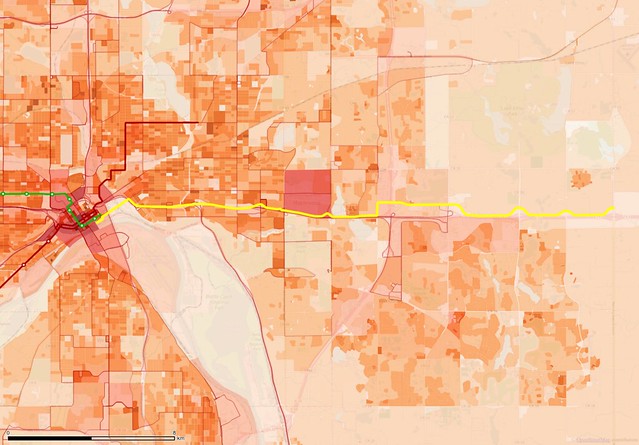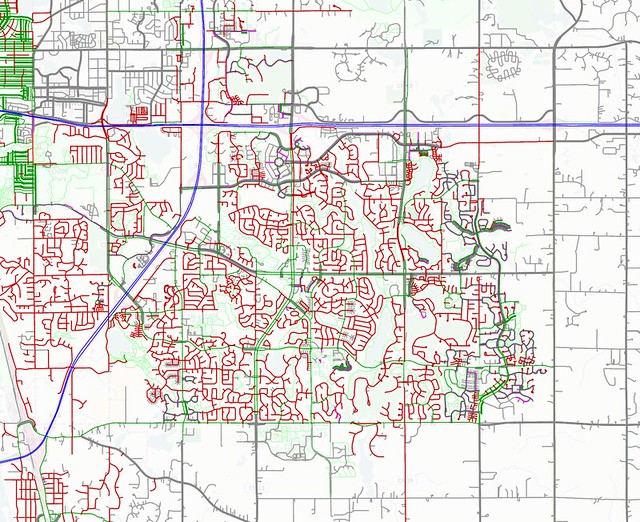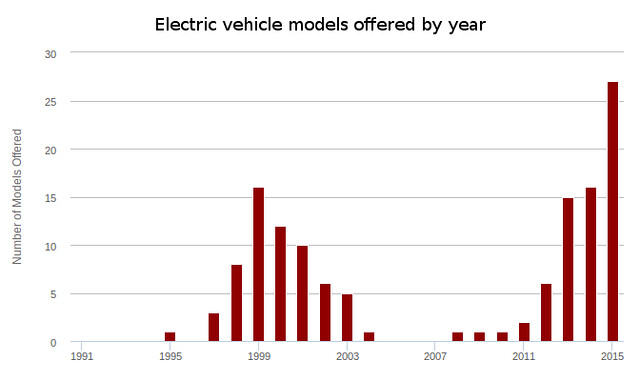
A decade ago, the electric car was declared dead. Now there are more models available than ever. (Source: AFDC)
In order to fight climate change, we're heading into a zero-carbon future. This is a problem that needs to be tackled in part by making cities and neighborhoods that are more walkable and bikeable with good access to mass transportation, but it's clear that many people and many places won't make the shift to those ways of getting around. Even in well-balanced urban areas, lots of families will only be able to go car-lite rather than car-free.
Automobiles will remain necessary, though they'll have to start being powered by electric motors fed by carbon-free energy. The state and local governments in Minnesota haven't been particularly active in encouraging the change toward electric vehicles so far, but continuing improvements mean that we will need to pay more attention.
The search for the practical zero-emission car has gone on a roller-coaster ride over the past couple of decades. This began with a burst of interest in EVs in the late 1990s due to mandates that were about to go into effect. California led the way since they have one of the world's most influential car markets, and several other states adopted similarly strict air pollution rules. There was heavy resistance to these requirements, however, and the electric car was declared dead less than a decade after that era began.
The 2006 documentary Who Killed the Electric Car? showed there was plenty of blame to go around. The film cited the usual suspects like the oil and automotive industries, but also pointed to government officials and a generally uninterested (albeit often uninformed) consumer base. Batteries were specifically absolved in the film's postmortem analysis, but it has to be acknowledged that they've had major feasibility problems in the past. Battery packs have been too heavy, too big, too expensive, had too little capacity, and taken too long to recharge. Still, there were some substantial improvements at the time, including a few cars that used new high-capacity lithium-ion batteries. These technological embers persisted in the ashes of that first pulse of EV development, and sparked a new generation of substantially better electric cars just a few years later.
Those initial EVs from the late '90s through the early noughties were only made available in limited regions, explicitly to comply with government mandates, and were they often only leased rather than sold. As far as I know, none of the models were made publicly available in Minnesota. Zero-emission vehicle mandates were pushed back by about a decade, but are beginning to exert force once again. Things are going a bit differently this time around, and sales of electric cars are picking up steam. By 2025, California will require more than 15% of new cars to be zero-emission vehicles.
While many manufacturers still only offer "compliance cars" in a few states, some models such as the Tesla Model S, BMW i3, and Nissan Leaf can be purchased locally. Recent years have also seen the emergence of plug-in hybrid vehicles which are able to run at least several miles on battery power alone before switching over to a gasoline engine, and many of those are being sold in all 50 states. The most well-known plug-in hybrid is probably the Chevrolet Volt, which has been billed as General Motors' response to Tesla, but many others have also appeared. The BMW i3 notably inhabits both camps, since a range-extending engine is available as an option.
These cars still command relatively high costs, but mass production is bringing prices down for batteries and the raft of other components unique to electric vehicles. Tesla, known for having the only cars with over 200 miles of range per charge, has set the price of their Model S upward of $70,000 (sans government tax credits). However, they struck a balance by including a host of compelling features in the car. This disguises the cost of the drivetrain, but allows it to be highly competitive with gas-powered cars in the same price tier.
Other electric cars have been sold at lower prices, but they've resorted to much smaller battery packs. Both the BMW i3 (upwards of $42,000) and the base edition of the Leaf (starting at $29,000) are prime examples, with just over 80 miles of range in their base configurations. This puts cities like St. Cloud, Rochester, and Duluth at or beyond the driving range of most electrics on the market today. Manufacturers are now racing to match the driving distance of Tesla's offerings while still aiming for distinctly mid-market prices—somewhere near the average cost of a new car ($33,560 last year).
Nissan has a bigger battery option available for the Leaf which brings range to 107 miles per charge and has hinted at even larger packs, and BMW recently indicated their i3 will get a range boost to about 120 miles for the 2017 model year, but those seem to just be incremental improvements. Tesla plans to offer a 200-mile-range vehicle for about $35,000 in 2017, but they may be beaten to the punch by General Motors. Earlier this month, GM showed off their Chevy Bolt (yes, with the most confusing name ever), which is also supposed to reach the 200-mile mark. Their goal is to enter production by the end of 2016. It's hard to say which one of these cars will reach consumers first, but they're both right around the corner.
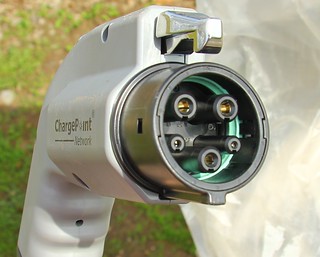
Level 2 chargers with SAE J1772 connectors dominate the national electric car charging infrastructure, but most aren't very speedy.
It becomes very challenging to use these AC chargers on longer journeys, though it's certainly not impossible to use them. On the 408-mile trip from Minneapolis to Chicago, using an electric car with Level 2 AC chargers could require more than double the normal drive time of a gas car, even with a head start on a battery filled with 200 miles of range. To make long-distance travel a reality, automakers are moving away from AC toward high-voltage direct current (more than 400 volts). However, this technology has been in greater flux, and there are three competing DC systems.
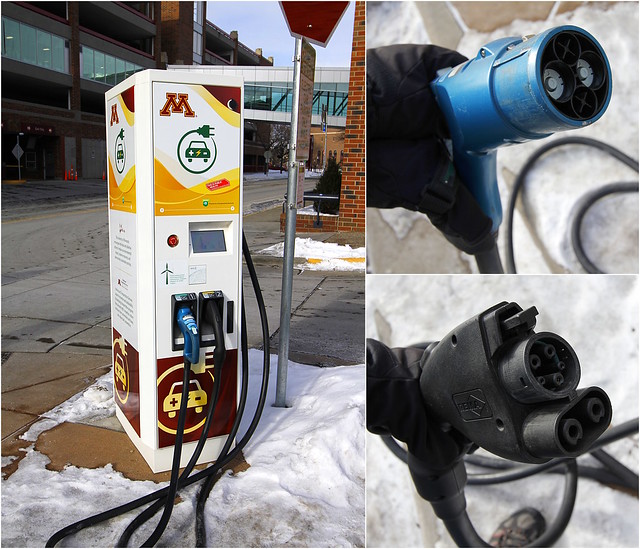
A dual-standard 50-kilowatt high-voltage DC charging station at the University of Minnesota sporting both CHAdeMO (blue) and CCS (black) connectors.
BMW and GM, along with other American and European companies, use the Combined Charging System (CCS). This is also known as "SAE Combo" in North America because it expands upon the previously-mentioned SAE J1772 standard by adding two extra DC pins on the bottom. A CCS port can accept either a low-power charge plug or a high-power one, though a high-power plug can't fit into a low-power socket. Despite that problem, it seems like it should be one of the more popular systems, but it's the youngest standard and the others have had a head start.
Nissan and other Japanese automakers use a system called CHAdeMO. This uses a large, round plug which isn't physically compatible with the SAE standard at all, so a high-speed charging socket needs to be placed adjacent to the normal low-speed SAE port on any vehicle that uses this system. CCS and CHAdeMO installations may vary in power between 20 kW up to about 60 kW, making them capable of restoring 60 to 180 miles of range to a 100 mpge car in an hour, although development is continuing on versions that will push that significantly higher.
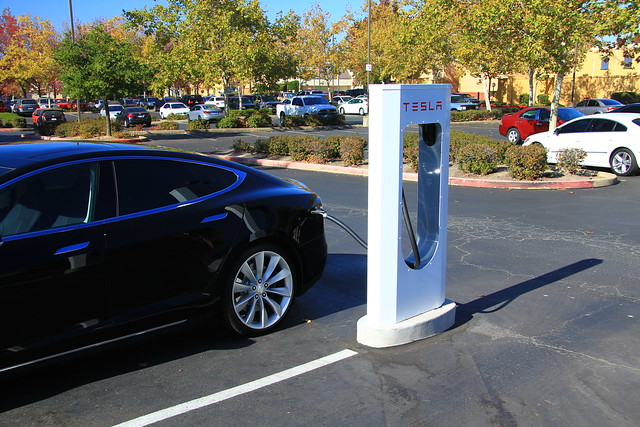
A Tesla Supercharger filling the battery of a Model S at a California outlet mall.
And that brings us to Tesla, who bring the smallest and sleekest design, able to do both low-speed and high-speed charging through a single unified connector. However, the downside is that this requires adapters whenever non-Tesla charging stations are encountered. Tesla offers adapters for both low-speed SAE and high-speed CHAdeMO plugs, but nothing (yet) for the CCS standard. Their high-speed charging system is called the Supercharger, and can pump 120 kilowatts of power or more, allowing peak charging rates of 360 miles per hour. Again, this ends up being slower in practice due to the slowdown as batteries fill up, but Tesla says that cars equipped with their 85 kilowatt-hour battery pack, good for 257 to 270 miles of range depending on model, can be fully recharged in 70 minutes.
There are already more than 3,500 fast DC chargers deployed through the country across the three different standards. Mapping them out, they reveal some surprising patterns.
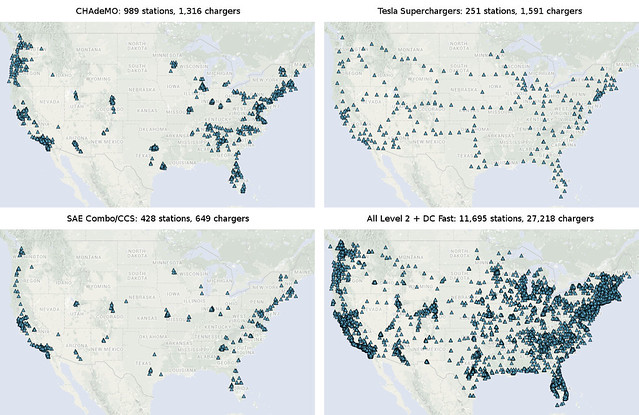
Deployment patterns for the various charging station types. Maps from AFDC.
The two standardized systems are mostly clustered in metropolitan areas, but include some corridors that were probably sponsored by state governments or other regional entities. CHAdeMO has the most stations, but CCS is catching up. One issue is that CHAdeMO and CCS installations usually only have one or two chargers per station, which can be troublesome if you need to charge and come across one that's already in use, blocked, or broken. The small sites greatly increase the chance that you'll have to go somewhere else or sit and wait for a long time to get an available charger.
Tesla appears to be the only entity that's thinking nationally about fast-charging infrastructure, and has stretched them along multiple corridors across the country, facilitating coast-to-coast travel. Notably, the first cross-country leg of the Supercharger network was built through southern Minnesota, and company employees used it to smash the record time for cross-country EV travel in February 2014. Tesla averages more than 4 chargers per station, and some installations have two or three times that number. Despite having the smallest number of stations, Tesla has the largest number of DC fast charger outlets and the broadest coverage area.
The company intended their Supercharger network to primarily be used for intercity travel, so they sometimes aren't available in metropolitan areas. Still, when combined with the extended coverage area available through the (somewhat expensive) CHAdeMO adapter, Tesla maintains a strategic advantage over other automakers.
Most new CHAdeMO and CCS stations are being built with dual-standard chargers, like the one from the University of Minnesota that I pictured above. Dual-standard chargers are apparently only about 5% more expensive than ones only operating on one of the two, so it makes sense to just include both types of connectors. It's conceivable that future stations may be triple- or quad-standard, including J1772 and/or Tesla adapters, allowing all types of vehicles to use them, but I hope one of the three fast-charging types will eventually become dominant and we won't have to worry about the mess of different plugs a decade from now.
For anyone who worries about being able to find a charge point, plug-in hybrid cars also offer an interim solution. Since they include a normal gasoline engine, they can be filled up like regular cars on long trips, but still benefit from using electricity when doing daily driving tasks. This segment of the car market is broadening pretty rapidly, though that's partly because states with zero-emission vehicle mandates are now allowing them to be partly fulfilled with these models (known as "transitional zero-emission vehicles" under California's regulations).
As an example of where this is headed, Chrysler recently announced they'll offer a plug-in hybrid version of their new Pacifica minivan, which the company claims can run 30 miles on electricity before shifting to power from the engine (it also has a built-in vacuum cleaner). Chevrolet also recently updated their Volt with better electric driving range (increased from 35 miles to 53) and improved gas engine fuel economy. However, in the long run, it looks like it will be cheaper and more practical for cars to be all-electric rather than dealing with the complexity of both an internal-combustion engine and a battery-powered drivetrain.
Electric charging will create a big shift in the way we get around, and will have an impact on the built environment. Homeowners are able to install chargers at home, so many drivers will only need to use public chargers on rare occasions. It's hazier what will happen for apartment-dwellers. Certainly some apartment complexes will get chargers, but it's a bit hard to imagine that everyone will be able to plug in overnight. There will always be some drivers who will need to fill up on the go.
Fast-chargers seem to be getting faster by the day, but it's not quite clear how fast they'll be able to become. The standard gas station/convenience store combination we're all familiar with will probably become morph into something different, but what? I expect increased demand for meaningful retail, entertainment, and restaurant options—at least something more substantial than the typical gas station hot dogs and junk food.
The electrification of the car is one of three major shifts that I expect to see in the automotive world over the next few decades, with the other two being self-driving cars and the transition toward car sharing services. Despite all the buzz it gets, I don't expect self-driving vehicles in themselves to significantly change the way we build cities. In contrast, car sharing has the potential to dramatically reduce the number of cars we need on the road—but only if people buy into the concept.
I expect the shift to electric driving to be somewhere in between. Notably, charging stations can fit into tight spaces and can meld with existing parking. They can be in lots or on the street, and sometimes show up in parking structures, such as the Superchargers in Duluth. The valuable city corners occupied by gas stations could still fill up just as many cars even after they're replaced with mixed-use buildings and have the adjacent streets lined with charging outlets.
For places that have seen traditional town centers depleted of commercial and retail activity in favor of areas around off-ramps and frontage roads, thoughtful placement of charging stations is also potentially useful tool for restoring more walkable alternatives.
Of course, while electric cars are quieter and far more efficient than their gasoline-powered rivals, but we still shouldn't give up our more walkable environments in order to accommodate them. We'll always have to remember that electric charging this is a form of parking, so charging spaces bring all of those associated benefits and costs. Choose your locations wisely.
